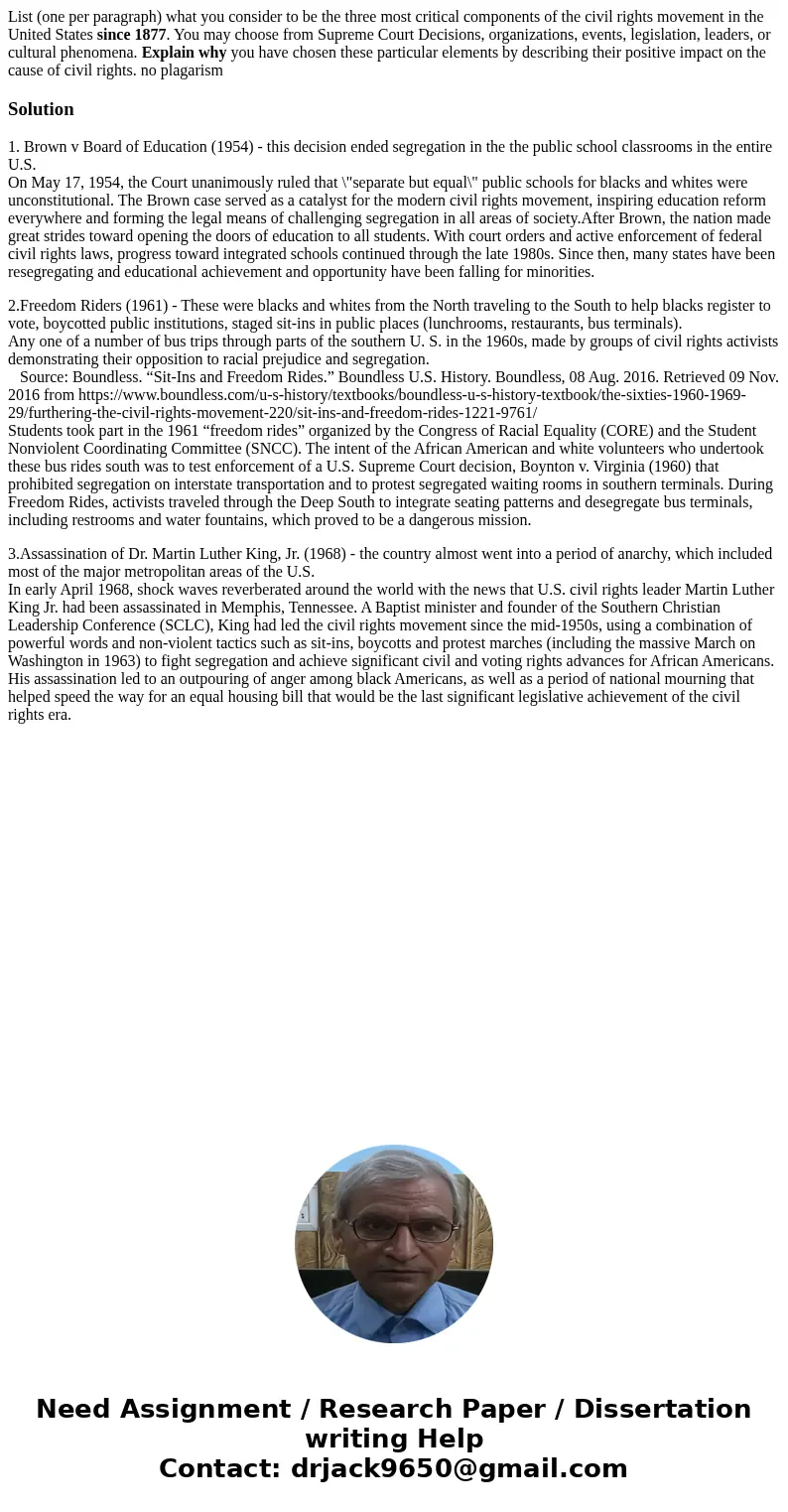List one per paragraph what you consider to be the three mos
List (one per paragraph) what you consider to be the three most critical components of the civil rights movement in the United States since 1877. You may choose from Supreme Court Decisions, organizations, events, legislation, leaders, or cultural phenomena. Explain why you have chosen these particular elements by describing their positive impact on the cause of civil rights. no plagarism
Solution
1. Brown v Board of Education (1954) - this decision ended segregation in the the public school classrooms in the entire U.S.
On May 17, 1954, the Court unanimously ruled that \"separate but equal\" public schools for blacks and whites were unconstitutional. The Brown case served as a catalyst for the modern civil rights movement, inspiring education reform everywhere and forming the legal means of challenging segregation in all areas of society.After Brown, the nation made great strides toward opening the doors of education to all students. With court orders and active enforcement of federal civil rights laws, progress toward integrated schools continued through the late 1980s. Since then, many states have been resegregating and educational achievement and opportunity have been falling for minorities.
2.Freedom Riders (1961) - These were blacks and whites from the North traveling to the South to help blacks register to vote, boycotted public institutions, staged sit-ins in public places (lunchrooms, restaurants, bus terminals).
Any one of a number of bus trips through parts of the southern U. S. in the 1960s, made by groups of civil rights activists demonstrating their opposition to racial prejudice and segregation.
Source: Boundless. “Sit-Ins and Freedom Rides.” Boundless U.S. History. Boundless, 08 Aug. 2016. Retrieved 09 Nov. 2016 from https://www.boundless.com/u-s-history/textbooks/boundless-u-s-history-textbook/the-sixties-1960-1969-29/furthering-the-civil-rights-movement-220/sit-ins-and-freedom-rides-1221-9761/
Students took part in the 1961 “freedom rides” organized by the Congress of Racial Equality (CORE) and the Student Nonviolent Coordinating Committee (SNCC). The intent of the African American and white volunteers who undertook these bus rides south was to test enforcement of a U.S. Supreme Court decision, Boynton v. Virginia (1960) that prohibited segregation on interstate transportation and to protest segregated waiting rooms in southern terminals. During Freedom Rides, activists traveled through the Deep South to integrate seating patterns and desegregate bus terminals, including restrooms and water fountains, which proved to be a dangerous mission.
3.Assassination of Dr. Martin Luther King, Jr. (1968) - the country almost went into a period of anarchy, which included most of the major metropolitan areas of the U.S.
In early April 1968, shock waves reverberated around the world with the news that U.S. civil rights leader Martin Luther King Jr. had been assassinated in Memphis, Tennessee. A Baptist minister and founder of the Southern Christian Leadership Conference (SCLC), King had led the civil rights movement since the mid-1950s, using a combination of powerful words and non-violent tactics such as sit-ins, boycotts and protest marches (including the massive March on Washington in 1963) to fight segregation and achieve significant civil and voting rights advances for African Americans. His assassination led to an outpouring of anger among black Americans, as well as a period of national mourning that helped speed the way for an equal housing bill that would be the last significant legislative achievement of the civil rights era.

 Homework Sourse
Homework Sourse